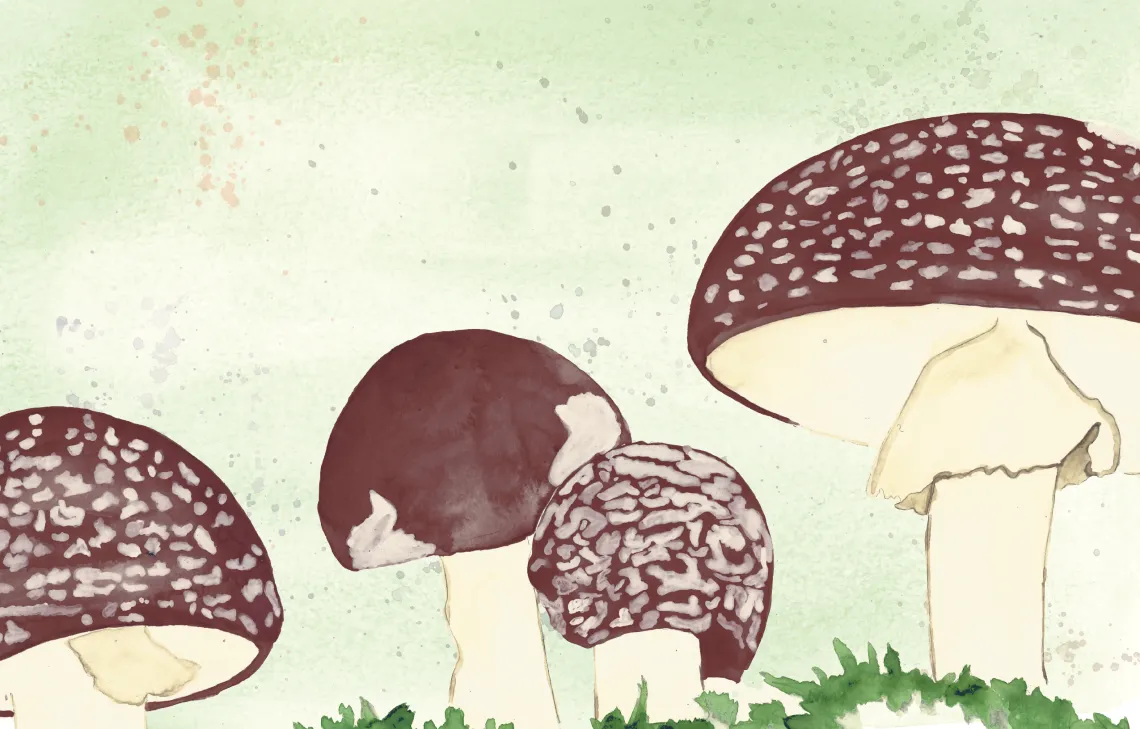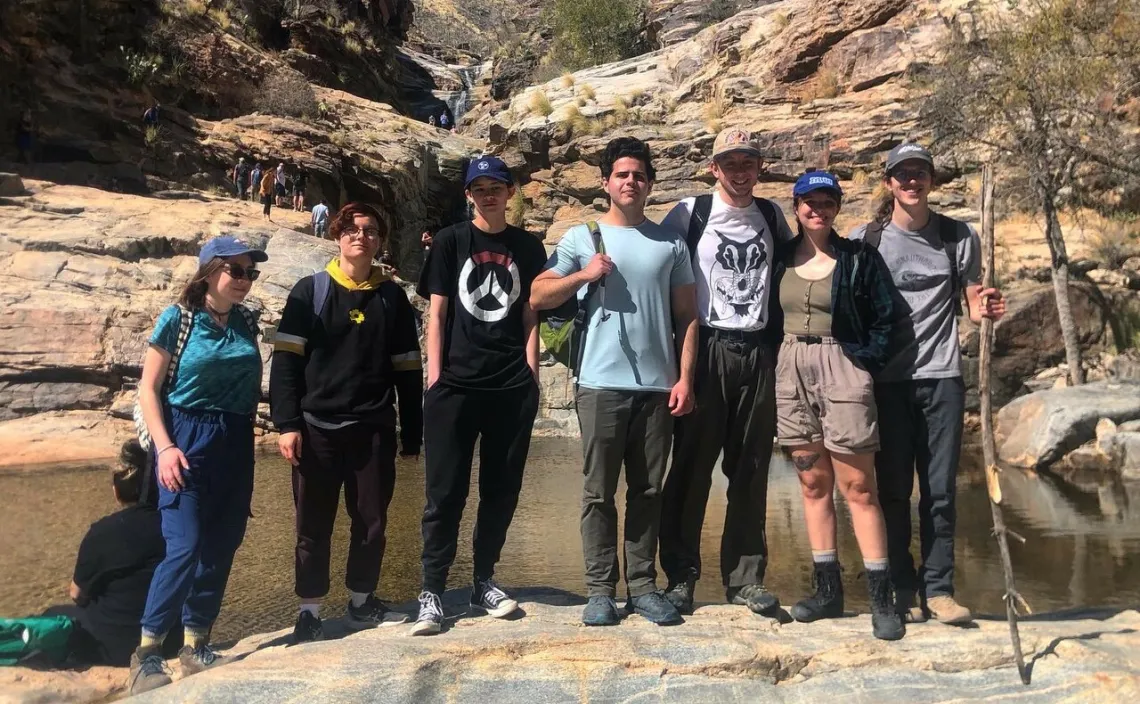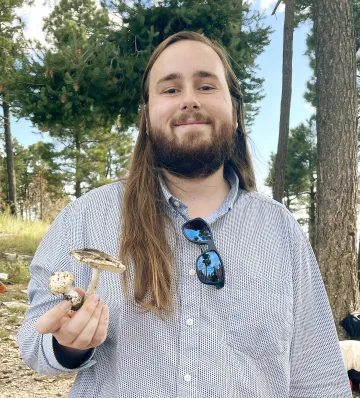All Things Fungi
MycoCats connect to each other and the mysterious mushroom world around them.

/ Patri Hadad illustration
Mycelia — the root-like structures of fungi — create the “neural network” of a forest. The fungal threads branch out like capillary veins through a body and connect into plants’ root systems in a massive underground network. The function of these networks is the topic of considerable scholarship today, including one theory that posits that plants can use the systems to transfer nutrients and send information, like warnings about nearby dangers such as pests or wildfire.
At the University of Arizona, mycelia not only connect the plants in the campus arboretum through an unseen underground network but also connect students. MycoCats is a student club dedicated to all things fungi. Originally founded with a focus on cultivation of edible and medicinal mushrooms, the club has expanded in recent years to include foraging for wild mushrooms and interests in mycomaterials and biological engineering.
The club uses a community-based chat app with over 150 active members and hosts in-person activities such as meetings, events and hikes that attract 20 or so regular participants. Its mission is to involve students in citizen science, provide a community for students to discuss all aspects of mushrooms and help students connect with the world around them, explains club president and geology major Caitlin Dowd.
“It was nice to join a community of students who are also interested in mycology,” says member Ken Gourley, a Ph.D. candidate in geosciences. “I know a lot about foraging for mushrooms, but I don’t know almost anything about cultivation. It feels good to share my knowledge of foraging and the identification of wild mushrooms with the rest of the students, while also getting knowledge from them about cultivation.”

The MycoCats club brings together students passionate about the hidden life of fungi, sometimes for hikes around Tucson.
/ MycoCats Club photo
“Our alumni are also a really great resource,” Dowd adds. “We have some alumni members with a fair amount of cultivation experience under their belt who are still active in our chat, answering questions. It’s nice to see that support from alumni.”
The club is an eclectic community — members span diverse majors, degree levels and backgrounds — connected through their shared interest in mushrooms. For Dowd, this sense of connection to others is a big part of her passion for the club.
“I clung to this club during the COVID-19 disruptions,” she says. “The foraging hikes we go on have been really refreshing for me as a way to make new friends and also see familiar faces. It’s been a nice way for me to have a sense of community through all the craziness.”
Erik Youngdahl, the club’s vice president of cultivation and a dual major in Arabic and anthropology, finds his cultivation projects to be a source of hope and inspiration.
“I was incredibly depressed and wanted to do something novel with my life, so I started growing oyster mushrooms,” he says. “It was soothing to see its entire life process unfold before my eyes. There’s always some new growth to look forward to.”
Youngdahl is heading up a club project to investigate the use of buffelgrass to grow mushrooms. “We regularly participate in buffelgrass pulls, and we’re experimenting with the possibility of using it as a substrate,” he explains. “We know it can be done, but we’re wondering what concentration of buffelgrass is ideal for growing mushrooms."
"It would be really cool if this awful, invasive species could be used for something positive.”
Youngdahl says he is pessimistic about climate change but finds ecological projects like this hopeful. “Even though it isn’t much in the grand scale of things, it gives me some reassurance that there are things that we can do on a local level to make a specific location better,” he says. “In areas where buffelgrass has been removed, you can see flowers growing, healthy soil and ecosystems. It’s a nice feeling to think humans helped make that happen.”
Dowd says that one of the club’s goals is to share information about the possibilities fungi have to contribute to many fields. “For example, in the mining industry, there is some interest in using mushroom blocks for soil reclamation, because mushrooms have been known to actually pull heavy metals out of soil.”
This type of mycoremediation might also be used to clean up oil spills and other environmental disasters. While the potential for mycelium application is great, there are still a lot of questions to be answered.
Gourley points to mushrooms’ symbiotic relationship with plants as one area scientists do not yet fully understand. “We’ve only been able to cultivate a couple dozen species of edible mushrooms, and primarily those are ones that don’t have a symbiotic relationship with plants,” he says.
“There’s still mystery and intrigue around fungus, and it makes foraging really rewarding because you cannot grow a lot of these mushrooms at home.”
Dowd enjoys being a citizen scientist and having a direct impact on scientific knowledge. She received local press attention for discovering a rare mushroom while foraging in the Mount Lemmon area of the Santa Catalina Mountains last summer. The mushroom, Entoloma occidentale variety metallicum, is a small, vibrantly purple mushroom and had never before been documented in Arizona.
When she found the rare mushroom, she connected with the Arizona Mushroom Society, which helped with DNA sequencing to identify it. The mushroom was then sent to the UArizona Mycological Herbarium, which is home to more than 40,000 dried fungal specimens.
“I think it’s good that mushrooms are getting their time in the limelight. They’re super understudied,” Dowd says. “The fact that we as students can help impact science by just uploading pictures of what we find to databases — that’s mind-blowing to me.”

